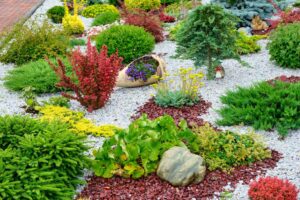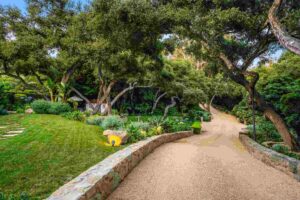Choosing the right plants for your yard can feel overwhelming. With thousands of species available, knowing which ones work best for your space takes some planning. The good news is that understanding basic plant categories makes the selection process much easier.
This guide breaks down the main types of plants used in landscaping and shows you how to pick the best options for your needs. Whether you want low maintenance plants outdoor or eye-catching focal points, you’ll find practical advice that works for real gardens.
Understanding Your Landscape
Examine your growing circumstance carefully before you move to select plants. Determine how much sun or shade each of your growing area’s gets during the day. Some areas may receive full sun with no shade while others are primarily shaded. Also take a mental note of where the water pools after rainfall, and where soil dries out quickly.
Climate zone also plays an important role. San Jose is located in USDA zone 9b, which allows for a very different plant palette than colder or hotter areas. Soil type should also be taken into consideration. For example, clay soil holds moisture longer than sandy soil, which has an impact on what may thrive in certain conditions.
Next, consider your desire. Are you looking to create a privacy screen? Do you want to provide color in your property throughout the year? Do you want a planting space that requires the least amount of care? The answers to these questions will ultimately determine the suitability of different plants for your site.
Understanding What Type of Plants Are Involved in Landscaping
Landscaping relies on several main plant categories, each serving specific purposes in your yard.
Trees form the backbone of most landscapes. They provide shade, block wind, and add vertical interest. Deciduous trees like maples lose leaves in fall, while evergreens like pines keep foliage year-round. Ornamental trees such as Japanese maples bring color and unique shapes without growing too large.
Shrubs fill the middle layer between trees and ground covers. These woody plants range from small border plants to large privacy hedges. Boxwoods, azaleas, and hydrangeas are popular choices that work in various settings.
Perennials come back year after year from the same root system. They die back in winter but regrow each spring. Daylilies, hostas, and lavender are classic examples that reduce replanting work.
Annuals complete their life cycle in one season. While they need replanting yearly, they offer non-stop color. Petunias, marigolds, and impatiens brighten beds and containers all summer.
Ground covers spread horizontally to fill spaces and prevent weeds. These low-growing plants like creeping thyme or mondo grass reduce lawn area and maintenance needs.
Grasses include both ornamental types and lawn grasses. Ornamental varieties like fountain grass add texture and movement. They handle drought better than traditional lawns.
Vines grow vertically on structures. Climbing roses, clematis, and jasmine soften fences and walls while taking up little ground space.
At Lakota Design Group, our landscape design in San Jose incorporates these plant types based on each property’s unique conditions and the owner’s lifestyle.
20 Best Landscaping Plants for a Low-Maintenance Garden
These best landscaping plants require minimal care once established, making them perfect for busy homeowners.
- Lavender tolerates drought and poor soil. Its purple flowers attract pollinators and produce a pleasant scent. Cut it back once yearly after blooming.
- Sedum stores water in thick leaves, making it one of the top no maintenance landscaping plants. It thrives in hot, dry spots where other plants struggle.
- Russian Sage grows tall with silvery foliage and purple blooms. It needs little water and handles heat without complaint.
- Daylilies bloom for weeks with almost no care. These tough perennials multiply over time and come in hundreds of colors.
- Coneflowers survive drought, poor soil, and neglect. Their daisy-like flowers feed butterflies and birds throughout summer.
- Ornamental Grasses like Karl Foerster feather reed grass add height and texture. They need only one annual trim in late winter.
- Rosemary functions as both herb and ornamental. This woody shrub needs no fertilizer and very little water once rooted in.
- Agapanthus produces stunning blue or white flower clusters on tall stems. It divides easily and resists most pests.
- Lantana blooms continuously in hot weather. This low maintenance front yard plants option attracts hummingbirds and butterflies while requiring minimal water.
- Yarrow spreads slowly to fill spaces. Its flat flower clusters come in many colors and dry beautifully for arrangements.
- Salvia offers dozens of varieties, all drought-tolerant and long-blooming. Its tubular flowers draw pollinators from spring through fall.
- Society Garlic grows in clumps with grass-like leaves and purple flowers. It repels deer and requires almost no attention.
- Mexican Bush Sage produces velvety purple flower spikes in late summer. Cut it back hard in early spring for best results.
- Artemisia features silvery foliage that contrasts beautifully with green plants. It thrives in dry conditions and poor soil.
- Catmint forms mounding plants covered in blue flowers for months. Shearing it back mid-summer triggers a second bloom flush.
- Blanket Flower handles heat and drought while blooming all season. Its red and yellow flowers need no deadheading.
- Hens and Chicks are succulent ground covers that spread slowly. They grow in cracks, containers, or garden beds with zero fuss.
- Gaura produces delicate white or pink flowers that flutter like butterflies. This airy plant fills spaces without looking crowded.
- Fountain Grass adds movement and texture to borders. Its feathery plumes last into winter, providing year-round interest.
- California Poppy reseeds itself yearly with bright orange blooms. This native plant needs no water once established and attracts beneficial insects.
When planning your garden, mix these plants with different heights, textures, and bloom times. This creates visual interest while keeping maintenance low. Group plants with similar water needs together for easier care.
Additional Plant Categories for Specific Purposes
Beyond the basics, specialized plants solve particular landscaping challenges.
Native plants adapt naturally to your region’s conditions. They support local wildlife, resist diseases, and need less water than non-natives. California natives like manzanita and ceanothus thrive in San Jose with minimal care.
Drought-tolerant plants survive on rainfall alone once established. Succulents, Mediterranean herbs, and many ornamental grasses fall into this category. They save water and maintenance time.
Shade plants brighten dim areas under trees or beside buildings. Ferns, coral bells, and astilbes bring color where sun-loving plants fail.
Edible plants combine beauty with function. Blueberry bushes, artichoke plants, and apple trees produce food while looking attractive. Many herbs work as border plants too.
Pollinator plants support bees, butterflies, and hummingbirds. Native milkweed, salvias, and penstemons provide nectar sources that help declining pollinator populations.
Creating Your Planting Plan
Start by sketching your yard on paper. Mark existing features like trees, paths, and buildings. Note sun patterns and problem areas like slopes or wet spots.
Choose a focal point for each view. This might be a specimen tree, colorful shrub grouping, or decorative container. Build other plantings around these anchors.
Layer plants by height. Place tall trees and shrubs in back or center, medium plants in the middle, and low ground covers in front. This creates depth and shows off each plant.
Repeat key plants throughout your design. Using the same shrub or perennial in multiple spots creates unity. Odd-numbered groupings look more natural than even numbers.
Consider year-round interest. Mix evergreens with deciduous plants, early bloomers with late ones, and plants with colorful fall foliage. This keeps your yard attractive every season.
Our team at Lakota Design Group specializes in creating sustainable planting plans that match San Jose’s climate and your lifestyle. We select plants that work together while minimizing future maintenance.
Conclusion
Understanding what type of plants are involved in landscaping helps you create a yard that looks great and fits your life. By choosing plants suited to your conditions and goals, you’ll spend less time on upkeep and more time enjoying your outdoor space. Start with reliable, low-maintenance options and add specialty plants as you gain experience. Ready to transform your landscape? Contact Lakota Design Group today for expert landscape design in San Jose that brings your vision to life.
FAQs
What plants need the least maintenance?
Perennials like sedum, daylilies, and ornamental grasses require minimal care once established. Native plants adapted to your region also need less attention than exotic species.
How many types of plants should I include?
Use at least three to five different plant types for visual interest. Mix trees, shrubs, perennials, and ground covers to create layers and texture.
What makes a plant drought-tolerant?
These plants have special features like thick leaves, deep roots, or waxy coatings that help them survive with less water. Mediterranean herbs and succulents are common examples.
Should I choose native plants?
Native plants offer advantages like lower water needs, better pest resistance, and support for local wildlife. They’re often the best low maintenance plants outdoor for your specific region.
When is the best time to plant?
Fall and early spring work best in most climates. Plants establish roots during cool weather before facing summer heat stress.





